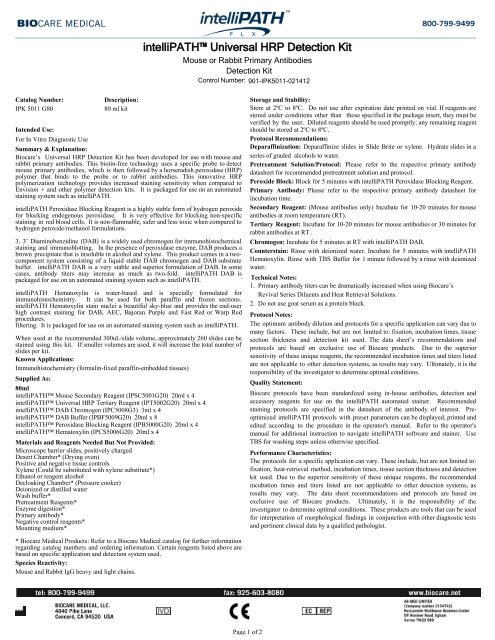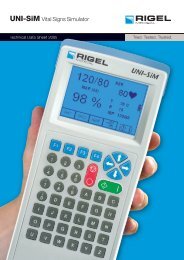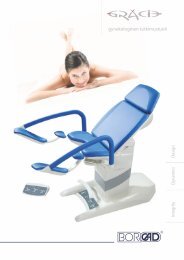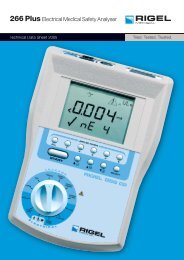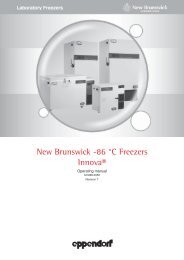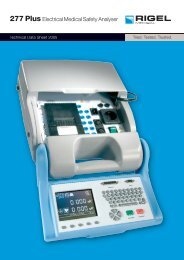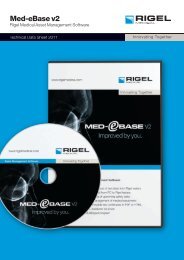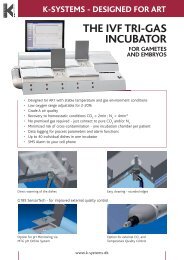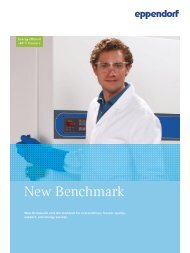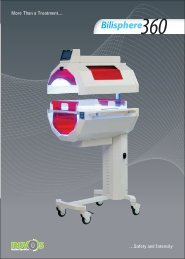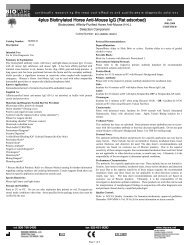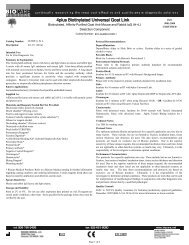Data Sheet - Biocare Medical
Data Sheet - Biocare Medical
Data Sheet - Biocare Medical
Create successful ePaper yourself
Turn your PDF publications into a flip-book with our unique Google optimized e-Paper software.
intelliPATH Universal HRP Detection Kit<br />
Mouse or Rabbit Primary Antibodies<br />
Detection Kit<br />
Control Number: 901-IPK5011-021412<br />
Catalog Number:<br />
IPK 5011 G80<br />
Intended Use:<br />
For In Vitro Diagnostic Use<br />
Description:<br />
80 ml kit<br />
Summary & Explanation:<br />
<strong>Biocare</strong>’s Universal HRP Detection Kit has been developed for use with mouse and<br />
rabbit primary antibodies. This biotin-free technology uses a specific probe to detect<br />
mouse primary antibodies, which is then followed by a horseradish peroxidase (HRP)<br />
polymer that binds to the probe or to rabbit antibodies. This innovative HRP<br />
polymerization technology provides increased staining sensitivity when compared to<br />
Envision + and other polymer detection kits. It is packaged for use on an automated<br />
staining system such as intelliPATH.<br />
intelliPATH Peroxidase Blocking Reagent is a highly stable form of hydrogen peroxide<br />
for blocking endogenous peroxidase. It is very effective for blocking non-specific<br />
staining in red blood cells. It is non-flammable, safer and less toxic when compared to<br />
hydrogen peroxide/methanol formulations.<br />
3, 3’ Diaminobenzidine (DAB) is a widely used chromogen for immunohistochemical<br />
staining and immunoblotting. In the presence of peroxidase enzyme, DAB produces a<br />
brown precipitate that is insoluble in alcohol and xylene. This product comes in a twocomponent<br />
system consisting of a liquid stable DAB chromogen and DAB substrate<br />
buffer. intelliPATH DAB is a very stable and superior formulation of DAB. In some<br />
cases, antibody titers may increase as much as two-fold. intelliPATH DAB is<br />
packaged for use on an automated staining system such as intelliPATH.<br />
intelliPATH Hematoxylin is water-based and is specially formulated for<br />
immunohistochemistry. It can be used for both paraffin and frozen sections.<br />
intelliPATH Hematoxylin stain nuclei a beautiful sky-blue and provides the end-user<br />
high contrast staining for DAB, AEC, Bajoran Purple and Fast Red or Warp Red<br />
procedures.<br />
filtering. It is packaged for use on an automated staining system such as intelliPATH.<br />
When used at the recommended 300uL/slide volume, approximately 260 slides can be<br />
stained using this kit. If smaller volumes are used, it will increase the total number of<br />
slides per kit.<br />
Known Applications:<br />
Immunohistochemistry (formalin-fixed paraffin-embedded tissues)<br />
Supplied As:<br />
80ml<br />
intelliPATH Mouse Secondary Reagent (IPSC5001G20) 20ml x 4<br />
intelliPATH Universal HRP Tertiary Reagent (IPT5002G20) 20ml x 4<br />
intelliPATH DAB Chromogen (IPC5008G3) 3ml x 4<br />
intelliPATH DAB Buffer (IPBF5009G20) 20ml x 8<br />
intelliPATH Peroxidase Blocking Reagent (IPB5000G20) 20ml x 4<br />
intelliPATH Hematoxylin (IPCS5006G20) 20ml x 4<br />
Materials and Reagents Needed But Not Provided:<br />
Microscope barrier slides, positively charged<br />
Desert Chamber* (Drying oven)<br />
Positive and negative tissue controls<br />
Xylene (Could be substituted with xylene substitute*)<br />
Ethanol or reagent alcohol<br />
Decloaking Chamber* (Pressure cooker)<br />
Deionized or distilled water<br />
Wash buffer*<br />
Pretreatment Reagents*<br />
Enzyme digestion*<br />
Primary antibody*<br />
Negative control reagents*<br />
Mounting medium*<br />
Storage and Stability:<br />
Store at 2ºC to 8ºC. Do not use after expiration date printed on vial. If reagents are<br />
stored under conditions other than those specified in the package insert, they must be<br />
verified by the user. Diluted reagents should be used promptly; any remaining reagent<br />
should be stored at 2ºC to 8ºC.<br />
Protocol Recommendations:<br />
Deparaffinization: Deparaffinize slides in Slide Brite or xylene. Hydrate slides in a<br />
series of graded alcohols to water.<br />
Pretreatment Solution/Protocol: Please refer to the respective primary antibody<br />
datasheet for recommended pretreatment solution and protocol.<br />
Peroxide Block: Block for 5 minutes with intelliPATH Peroxidase Blocking Reagent.<br />
Primary Antibody: Please refer to the respective primary antibody datasheet for<br />
incubation time.<br />
Secondary Reagent: (Mouse antibodies only) Incubate for 10-20 minutes for mouse<br />
antibodies at room temperature (RT).<br />
Tertiary Reagent: Incubate for 10-20 minutes for mouse antibodies or 30 minutes for<br />
rabbit antibodies at RT .<br />
Chromogen: Incubate for 5 minutes at RT with intelliPATH DAB.<br />
Counterstain: Rinse with deionized water. Incubate for 5 minutes with intelliPATH<br />
Hematoxylin. Rinse with TBS Buffer for 1 minute followed by a rinse with deionized<br />
water.<br />
Technical Notes:<br />
1. Primary antibody titers can be dramatically increased when using <strong>Biocare</strong>’s<br />
Revival Series Diluents and Heat Retrieval Solutions.<br />
2. Do not use goat serum as a protein block.<br />
Protocol Notes:<br />
The optimum antibody dilution and protocols for a specific application can vary due to<br />
many factors. These include, but are not limited to: fixation, incubation times, tissue<br />
section thickness and detection kit used. The data sheet’s recommendations and<br />
protocols are based on exclusive use of <strong>Biocare</strong> products. Due to the superior<br />
sensitivity of these unique reagents, the recommended incubation times and titers listed<br />
are not applicable to other detection systems, as results may vary. Ultimately, it is the<br />
responsibility of the investigator to determine optimal conditions.<br />
Quality Statement:<br />
<strong>Biocare</strong> protocols have been standardized using in-house antibodies, detection and<br />
accessory reagents for use on the intelliPATH automated stainer. Recommended<br />
staining protocols are specified in the datasheet of the antibody of interest. Preoptimized<br />
intelliPATH protocols with preset parameters can be displayed, printed and<br />
edited according to the procedure in the operator's manual. Refer to the operator's<br />
manual for additional instruction to navigate intelliPATH software and stainer. Use<br />
TBS for washing steps unless otherwise specified.<br />
Performance Characteristics:<br />
The protocols for a specific application can vary. These include, but are not limited to:<br />
fixation, heat-retrieval method, incubation times, tissue section thickness and detection<br />
kit used. Due to the superior sensitivity of these unique reagents, the recommended<br />
incubation times and titers listed are not applicable to other detection systems, as<br />
results may vary. The data sheet recommendations and protocols are based on<br />
exclusive use of <strong>Biocare</strong> products. Ultimately, it is the responsibility of the<br />
investigator to determine optimal conditions. These products are tools that can be used<br />
for interpretation of morphological findings in conjunction with other diagnostic tests<br />
and pertinent clinical data by a qualified pathologist.<br />
* <strong>Biocare</strong> <strong>Medical</strong> Products: Refer to a <strong>Biocare</strong> <strong>Medical</strong> catalog for further information<br />
regarding catalog numbers and ordering information. Certain reagents listed above are<br />
based on specific application and detection system used.<br />
Species Reactivity:<br />
Mouse and Rabbit IgG heavy and light chains.<br />
Page 1 of 2
intelliPATH Universal HRP Detection Kit<br />
Mouse or Rabbit Primary Antibodies<br />
Detection Kit<br />
Control Number: 901-IPK5011-021412<br />
Quality Control:<br />
Refer to CLSI Quality Standards for Design and Implementation of<br />
Immunohistochemistry Assays; Approved Guideline-Second edition (I/LA28-A2).<br />
CLSI Wayne, PA, USA (www.clsi.org). 2011<br />
Precautions:<br />
This product is not classified as hazardous. The preservative used in this reagent is<br />
Proclin 950 and the concentration is less than 0.25%. Overexposure to Proclin 950 can<br />
cause skin and eye irritation and irritation to mucous membranes and upper respiratory<br />
tract. The concentration of Proclin 950 in this product does not meet the OSHA<br />
criteria for a hazardous substance. Wear disposable gloves when handling reagents.<br />
Specimens, before and after fixation, and all materials exposed to them should be<br />
handled as if capable of transmitting infection and disposed of with proper precautions.<br />
Never pipette reagents by mouth and avoid contacting the skin and mucous membranes<br />
with reagents and specimens. If reagents or specimens come in contact with sensitive<br />
areas, wash with copious amounts of water. Microbial contamination of reagents may<br />
result in an increase in nonspecific staining. Incubation times or temperatures other<br />
than those specified may give erroneous results. The user must validate any such<br />
change. The MSDS is available upon request and is located at http://biocare.<br />
net/support/msds/.<br />
Consult OSHA, federal, state or local regulations for disposal of any toxic substances.<br />
Proclin TM is a trademark of Rohm and Haas Company, or of its subsidiaries or<br />
affiliates.<br />
Warnings:<br />
1. DAB is known to be a suspected carcinogen.<br />
2. Do not expose DAB components to strong light or direct sunlight.<br />
3. Wear appropriate personal protective equipment and clothing.<br />
4. DAB may cause sensitization of skin. Avoid contact with skin and eyes.<br />
5. Observe all federal, state and local environmental regulations.<br />
Troubleshooting:<br />
Follow the reagent specific protocol recommendations according to data sheet<br />
provided. If atypical results occur, contact <strong>Biocare</strong>'s Technical Support at 1-800-542<br />
-2002.<br />
Troubleshooting Guide:<br />
No Staining<br />
1. Critical reagent (such as primary antibody) omitted.<br />
2. Staining steps performed incorrectly or in the wrong order.<br />
3. Heat-induced epitope retrieval (HIER) step was performed incorrectly using the<br />
wrong time, the wrong order or the wrong pretreatment.<br />
4. Insufficient amount of antigen.<br />
5. Secondary antibody at too low of a concentration.<br />
6. Primary antibody incubation period too short.<br />
7. Improperly mixed substrate and/or chromogen solution(s).<br />
Weak Staining<br />
1. Tissue is either over-fixed or under-fixed.<br />
2. Primary antibody incubation too short.<br />
3. Low expression of antigen.<br />
4. Heat-induced epitope retrieval (HIER) steps performed incorrectly using wrong<br />
time, in the wrong order, or the wrong pretreatment.<br />
5. Over-development of substrate.<br />
6. Excessive rinsing during wash steps.<br />
7. Omission of critical reagent.<br />
8. Incorrect procedure in reagent preparation.<br />
9. Improper procedure in test steps.<br />
Non-specific or High Background Staining<br />
1. Tissue is either over-fixed or under-fixed.<br />
2. Incorrect blocking reagent used; blocker should be from same species in which the<br />
secondary antibody was raised.<br />
3. Tissue may need a longer or a more specific protein block.<br />
4. Substrate is overly-developed.<br />
5. Tissue was inadequately rinsed.<br />
6. Deparaffinization incomplete.<br />
7. Tissue damaged or necrotic.<br />
Troubleshooting Cont'd:<br />
Tissues Falling off<br />
1. Slides were not positively charged.<br />
2. A slide adhesive was used in the waterbath.<br />
3. Tissue was not dried properly.<br />
4. Tissue contained too much fat or poorly processed.<br />
Specific Staining Too Dark<br />
1. Concentrated antibody not diluted out properly (being used at too high of a<br />
concentration).<br />
2. Incubation of primary antibody, or detection too long.<br />
Limitations & Warranty:<br />
There are no warranties, expressed or implied, which extend beyond this description.<br />
<strong>Biocare</strong> is not liable for property damage, personal injury, or economic loss caused by<br />
this product.<br />
Page 2 of 2


